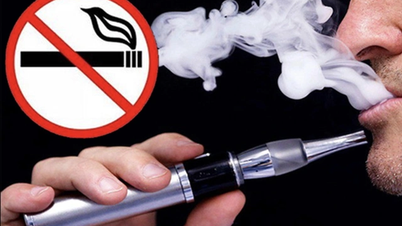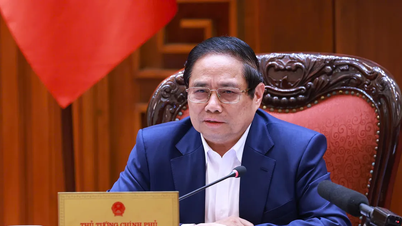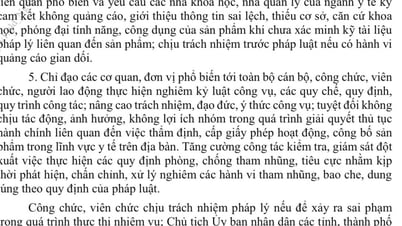Over the years, increasing tobacco taxes has been proven by many countries around the world to be one of the effective measures to reduce tobacco consumption and protect public health.
Experience in raising tobacco tax in the world and opportunities for Vietnam
Over the years, increasing tobacco taxes has been proven by many countries around the world to be one of the effective measures to reduce tobacco consumption and protect public health.
Reduce consumption by increasing taxes
Countries around the world have adopted tobacco tax increases in various forms and have achieved positive results in reducing smoking rates, especially among young people.
 |
| Over the years, increasing tobacco taxes has been proven by many countries around the world to be one of the effective measures to reduce tobacco consumption and protect public health. |
For Vietnam, a country facing serious health problems caused by tobacco, adopting international experience in raising tobacco taxes could be an important step in the fight against the harmful effects of tobacco.
For example, in the Philippines, the country has achieved impressive results in reducing smoking rates by 30% and increasing tax revenues by more than 400% after tobacco tax reform.
In 2012, the Philippines began a tobacco tax reform process by consolidating four excise tax rates into a single rate in 2017, followed by a further increase of 5 pesos per pack of cigarettes each year, reaching 60 pesos (equivalent to 1 USD) per pack of cigarettes in 2023. This reform raised the excise tax on premium-grade cigarettes by 110% and on mid-grade cigarettes by more than 700% compared to 2012.
As a result, the smoking rate in the Philippines has dropped sharply from 27% in 2009 to 19.5% in 2021, equivalent to a 30% reduction. At the same time, revenue from special consumption tax increased from about 680 million USD in 2012 to 2.9 billion USD in 2022.
Tobacco tax reform in the Philippines is a clear example of a “win-win” policy - protecting public health while increasing national revenue.
In Thailand, from 1993 to 2017, the Thai government increased excise tax on cigarettes 11 times, an average of about once every 2 years.
As a result, tobacco taxes increased from 55% to 90% of the taxed wholesale price (equivalent to an increase from 120% of the factory price to 693% of the factory price if calculated using Vietnam's tax calculation method).
In 2017, Thailand continued to reform tobacco taxes, switching from a proportional tax system to a mixed tax system with tax rates of: 20% of retail price (for cigarettes 60 THB/pack) plus 1.2 THB/cigarette.
As a result, budget revenue increased more than four times (from 500 million USD in 1993 to nearly 2.3 billion USD in 2017), the smoking rate (both men and women) nationwide decreased from 32% (in 1991) to 19.91% (in 2017), while cigarette output did not change much, fluctuating around 2 billion packs per year.
Experience in tobacco tax reform in Thailand and the Philippines has shown that imposing high taxes and steadily increasing tobacco taxes has helped reduce smoking rates, reduce tobacco consumption in the community, and increase tax revenue from tobacco.
Australia is one of the pioneering countries in increasing tobacco taxes to reduce smoking rates. The Australian Government has implemented a series of tobacco tax increases since 2010 and has set a roadmap for continuous tax increases until 2020.
One of the notable results is that the smoking rate in Australia has decreased from 16.2% in 2010 to 11.6% in 2020.
In addition to tax increases, Australia has also implemented strong communication campaigns, including graphic health warnings on cigarette packaging and the "No Smoking Day" campaign. The combination of tax increases and publiceducation measures has had a synergistic effect in reducing tobacco consumption.
The UK is also a country with a strong tobacco tax policy. The UK government has introduced excise duty on tobacco and has implemented annual tax increases.
According to statistics, when cigarette taxes are increased, cigarette consumption has decreased significantly, especially among young people. Although tax increases sometimes encounter opposition from manufacturers and consumers, studies show that this policy has helped reduce the rate of smokers, while increasing revenue for the national budget.
In New Zealand, the government has implemented a policy of increasing tobacco taxes continuously over the past decade and achieved very positive results.
According to research, tax increases have reduced smoking rates among adults and young people. New Zealand has also set a goal of becoming a “tobacco-free” country by 2025, supported by strong tobacco tax increases and health promotion campaigns.
What experience for Vietnam?
Vietnam is currently among the countries with the highest smoking rates in Southeast Asia. According to a survey by the World Health Organization (WHO), the rate of adults using tobacco in Vietnam is up to more than 40%.
These figures show that increasing tobacco taxes is an urgent measure to reduce the harmful effects of tobacco on public health, especially in the context of rapidly increasing tobacco-related diseases.
Currently, Vietnam is applying a relatively low tobacco tax compared to other countries in the region. According to a study by the World Health Organization (WHO), the tobacco tax in Vietnam accounts for only about 35% of the retail price, while this figure in countries such as Australia, the UK or Canada is about 70-80%.
The Vietnamese government can learn from the experiences of these countries to increase tobacco taxes, thereby reducing the attractiveness of cigarettes to consumers.
International studies have shown that raising tobacco taxes is one of the most effective ways to reduce smoking among young people. Making cigarettes more expensive will encourage many people, especially young people, to give up the habit.
Vietnam is currently facing a growing rate of smoking among teenagers, so a strong tobacco tax policy could help discourage the habit from an early age.
By increasing tobacco taxes, Vietnam can generate a large source of revenue for the national budget. However, tax revenue must be used for the right purposes, especially for tobacco prevention and public health care.
Governments can invest in campaigns to educate people about the harmful effects of tobacco, support people who want to quit, and improve health services for people with tobacco-related diseases.
Increasing tobacco taxes is one of the most effective measures to reduce smoking rates, especially when combined with comprehensive tobacco control strategies.
Countries such as Australia, the UK and New Zealand have demonstrated that raising tobacco taxes can reduce smoking rates, protect public health and save on healthcare costs.
To effectively reduce tobacco consumption, the World Health Organization recommends adding a specific tax (to move to a mixed tax system) at a sufficiently high level and increasing the tax in a regular manner so that tobacco prices keep up with income growth and gradually move towards the optimal tax rate of 75% of the retail price to contribute to the goal of reducing tobacco use.
The addition of absolute tax in the special consumption tax structure is consistent with the recommendations of the World Health Organization and international trends.
The WHO Guidelines for the Implementation of Article 6 of the Framework Convention on Tobacco Control state that Parties should consider implementing a system of absolute or mixed excise duties, with minimum prices for tobacco products, as these tax systems have advantages over purely ad valorem tax systems.”.
According to the World Health Organization report, the number of countries applying proportional taxes is decreasing (from 45 countries in 2010 to 34 countries in 2022), and the trend of switching to absolute or mixed tax systems (levying both proportional and absolute taxes) is increasing (in the period from 2010 to 2022, the number of countries applying mixed taxes increased from 51 to 64 countries; the number of countries applying absolute taxes also increased from 59 to 70 countries).
In the Southeast Asia region, there are 6 countries currently applying absolute tax system (Brunei, Indonesia, Malaysia, Philippines, Singapore, Myanmar), 2 countries applying mixed tax (Laos, Thailand) and only 2 countries still applying proportional tax including Vietnam and Cambodia.
Regarding tax rates, to ensure the achievement of the goal of reducing tobacco use according to the National Strategy on Tobacco Harm Prevention by 2030 approved by the Prime Minister, the Ministry of Health and the World Health Organization recommend adding an absolute tax rate on tobacco products at a rate of at least VND 5,000/pack by 2026 and gradually increasing to VND 15,000/pack by 2030, in addition to the current tax rate. The specific recommended plan is as follows:
Recommendations on special consumption tax on tobacco | ||
Year | Special consumption tax (VND/package) | Rate tax (% of manufacturer's or importer's selling price) |
2026 | 5,000 | 75% |
2027 | 7,500 | 75% |
2028 | 10,000 | 75% |
2029 | 12,500 | 75% |
2030 | 15,000 | 75% |
This recommended plan of the Ministry of Health and WHO will help reduce the smoking rate among men and women to below 36% and 1.0% respectively by 2030, thereby achieving the goals of the National Strategy on Tobacco Harm Prevention in Vietnam.
This option would also significantly reduce the total number of smokers, with a reduction of about 696,000 people in 2030 compared to 2020.
This option would also increase real, inflation-adjusted, annual tax revenue by 169%, equivalent to an additional VND29.3 trillion per year in tobacco tax revenue compared to 2020.
Source: https://baodautu.vn/kinh-nghiem-tang-thue-thuoc-la-tren-the-gioi-va-co-hoi-cho-viet-nam-d231480.html


![[Photo] Readers line up to visit the photo exhibition and receive a special publication commemorating the 135th birthday of President Ho Chi Minh at Nhan Dan Newspaper](https://vphoto.vietnam.vn/thumb/1200x675/vietnam/resource/IMAGE/2025/5/17/85b3197fc6bd43e6a9ee4db15101005b)


![[Photo] Prime Minister Pham Minh Chinh chairs meeting on science and technology development](https://vphoto.vietnam.vn/thumb/1200x675/vietnam/resource/IMAGE/2025/5/17/ae80dd74c384439789b12013c738a045)
![[Photo] More than 17,000 candidates participate in the 2025 SPT Competency Assessment Test of Hanoi National University of Education](https://vphoto.vietnam.vn/thumb/1200x675/vietnam/resource/IMAGE/2025/5/17/e538d9a1636c407cbb211b314e6303fd)































![[Photo] Nearly 3,000 students moved by stories about soldiers](https://vphoto.vietnam.vn/thumb/1200x675/vietnam/resource/IMAGE/2025/5/17/21da57c8241e42438b423eaa37215e0e)
































































Comment (0)